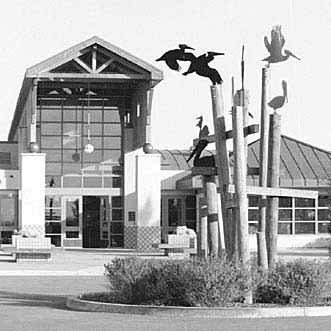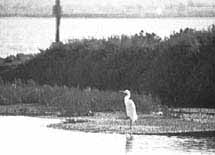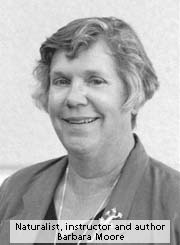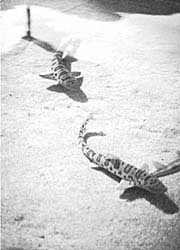![]()
![]()
![]()
![]()
![]()
![]()
![]()
A visitor to the Chula Vista Nature Interpretive Center would never know it all started with ...

KOYAANISQATSI (fr. the Hopi language) n. 1) crazy life, 2) life in turmoil, 3) life out of balance, 4) life disintegrating, 5) a state of life that calls for another way of living.
by Jack Innis
![]() steered my pickup truck over the tan ripples on the
one-lane dirt road to the Chula Vista Nature Interpretive Center, aware
of a growing sense of imbalance. Bordered on the west by a shallow bay,
on the east by an angry snarl of freeways, on the north by faceless walls
of warehouses, and on the south by a shipyard, the 300-acre nature reserve
seemed out of place, like an oasis in the sand.
steered my pickup truck over the tan ripples on the
one-lane dirt road to the Chula Vista Nature Interpretive Center, aware
of a growing sense of imbalance. Bordered on the west by a shallow bay,
on the east by an angry snarl of freeways, on the north by faceless walls
of warehouses, and on the south by a shipyard, the 300-acre nature reserve
seemed out of place, like an oasis in the sand.
From across the flat marsh, I eyed the NIC complex.
Its New England boathouse architecture is centered around a storied central
hall with a peaked roof. The hall is intersected by a long, round-roofed
Quonset hut on one side and a flat-roofed hall on the other. The complex,
though beautiful, doesn't fit. It stands huge and alone, like a castle in
the desert.
I found a spot to pull over and reviewed my
research on how this enigma came to be. The Chula Vista Nature Interpretive
Center began, more or less, with the bridge to nowhere. On July 13, 1987
the Sierra Club obtained an injunction which halted construction of the
I-5 to I-805 interchange and the extension of the South Bay Freeway (Route
54). The injunction was issued to force the U.S. Army Corps of Engineers
to begin dialogue with the U.S. Fish and Wildlife Service about protecting
two endangered bird species: the least tern and the light-footed clapper
rail. The injunction also created a bridge to nowhere - a closed-off half
bridge which became a familiar sight to South Bay motorists. This was happening
at a time when the Chula Vista Redevelopment Agency was pushing for a 400-room
resort hotel on a piece of bay front property at the foot of E Street. The
property was known as Gunpowder Point, home of the Hercules Gunpowder Company
during the early 1900s.
For months, a pitched battle was fought between the
Sierra Club, CalTrans, City of Chula Vista, Army Corps of Engineers, U.S.
Fish and Wildlife, California Department of Fish and Game, Santa Fe Land
Improvement Co., Chula Vista Investment Co., and Watt Industries. When the
smoke finally cleared over Chula Vista, Gunpowder Point was chosen to mitigate
the freeway right-of-way.
A bus-full of grade-school children, fresh from exploring
the 10,000 square-foot exhibit building, approached. I waved at the driver
and heard the happy cacophony of young voices as the bus passed by. I pondered
the paradox of a wildlife refuge situated atop an old gunpowder factory
and thought of a Hopi prophecy, handed down from generation to generation:
"If we dig precious things from the land, we will invite disaster."

The hub of the NIC is the galleria, which is
inside the huge central hall I had observed. In it are over 20 aquaria and
several interactive displays designed to enlighten children about our fragile
environment. I became acquainted with the displays, photographed a family
from San Antonio, and wondered who would be leading me on the behind-the-scenes
tour of the nature reserve.
Barbara Coffin Moore is the kind of naturalist that
naturalists are made of. She has been a docent and instructor at the Scripps
Aquarium for the past 18 years, she has coauthored a book, "Walking
San Diego," and she has lead thousands of nature walks throughout San
Diego County. Barbara is the NIC's Coordinator of Volunteers. When she isn't
busy at the NIC, she may be found teaching at Scripps, tagging monarch butterflies,
weighing sea turtles at Bahia de Los Angeles in Baja California, or touring
the elephant seal rookery at Año Nuevo State Park.
Barbara shares her Del Mar home with a seven-toed ginger
cat named Tiger Lily; an endangered (and registered) desert tortoise named
Napoleon; a lilac-crowned parrot named Chili Verde she caught in her eucalyptus
tree; and a recently purchased parrot named Salsa that keeps Chili company.
Barbara unlocked the gate and we began our 90-minute
walking tour of the grounds around the NIC. "We have lost 90 percent
of our wetlands in San Diego County," she explained. "There are
only about 3,000 acres left and we sit on 316 acres, including 46 acres
of upland."
As we walked, Barbara pointed to signs of the land's
tainted past; remnants of a World War II gun emplacement, tens-of-thousands
of bricks from the abandoned gunpowder plant, a silted-up canal and railroad
tracks. Yet, Barbara told me, the most severe degradation to Gunpowder Point
was done in the seventies and eighties. "One of the prior landowners
used to come down here on the weekends and charge people to let them dump
their trash," she said. "We have taken more than 90,000 tons of
trash out of here. The first and second year, we had inmates from the Donovan
Correctional Facility here for three or four months at a time, literally
loading up dumpster after dumpster."

We walked across a large plank that had been washed
up at high tide. I picked up several pieces of pink and light blue glass
and held them up to the sun. "Those are relics," Barbara said,
"When we have docent-led tours, we have to remind people not to take
them home with them." I returned the relics to the sand.
"One of the big projects coming out in the spring
is trail delineation," she said. "People will then be able to
come out on their own by checking in at the book store. Until three years
ago, the U.S. Fish and Wildlife didn't want the public out here at all,
even on docent-led tours. In exchange for allowing people to come out here
on their own, we've agreed to revegetate this 46 acres of upland. Since
all of the land here was farmed in the '40s, '50s, '60s and '70s, all the
old coastal sage scrub is gone. We're going to reintroduce an entire endangered
habitat," she said.
Back at the NIC, we toured the burrowing owl exhibit,
the stingray petting pond, the abalone farm, and NIC's classrooms and research
laboratories. I was amazed that such a special place could exist, unknown
to so many.
As I left the NIC that afternoon, I thought about the
century of abuse mankind had afflicted upon Gunpowder Point, the gallant
dedication of naturalists like Barbara Moore, and KOYAANISQATSI, a state
of life that calls for another way of living.
![]()
Jack Innis is a freelance writer from Oceanside, California. More
than 40 of his outdoor and environmental articles have been published nationwide.
He is an alumnus of San Jose State University with majors in English and
industrial design